PROLERO
PROLERO is a PROtotype of LEgged ROver, also known as WAlking RObot for Mars Applications (WAROMA). The concept of WAROMA was developed in the ESA A&R group and a prototype of it was built by PROLERO Industries (NL) on ESA contract.
InterMarsnet was a proposed ESA science mission to Mars where a micro mobile robot was intended to apply instruments in the surroundings of a small lander. The microrover had to fulfil the requirements below.
- Stowed dimensions: 22x23x8 cm
- Mass of Mars Instrument Deployment Device (IDD): 1.5 kg
- Total lifetime: 200 days
- Maximum obstacle height: 10 cm
- Peak power: 3 W
- Temperature range: -120/+60 C
- Payload mass 1.5 kg
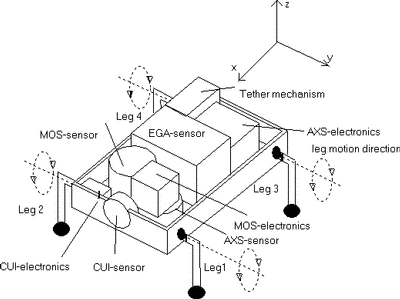
It is evident that this mission imposed severe constraints in mass and power for the design of all mobile robot actuators and gear boxes needed for every degree of freedom.
The WAROMA (WAlking RObot for Mars Applications) was proposed by the A&R Section as candidate for the microrover.
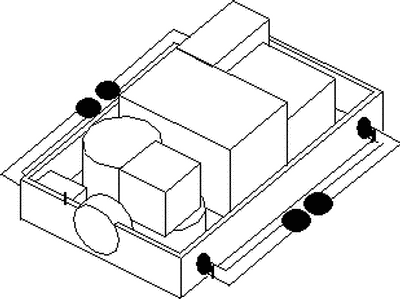
WAROMA had only four flexible L-shaped legs, where each leg had only one degree of freedom. Therefore the total mass and mechanical complexity was reduced compared to more classical walking robot where up to 2/3 actuators per leg are present (e.g. Dante, Ambler).
Operation modes
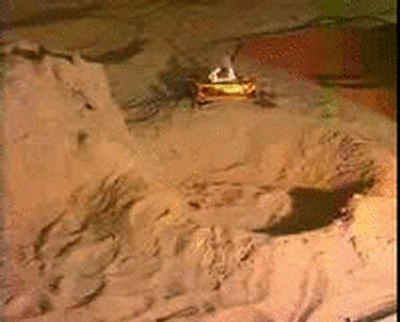
Depending of the mission phase and working situation, several operation modes were identified for WAROMA.
Stowage mode
WAROMA had excellent storage capabilities, as the legs can be placed close to the body, needed when it is stowage inside the mother spacecraft.
Nominal Walking mode
a wave gait with a duty factor (ß) of 0.5 seemed very convenient since it was the only one that reduces the interaction forces among legs and therefore the slippage phenomenon and energetic losses.
In this gait there are main two phases: the supporting-pushing phase and transfer phase.
This mode includes turning motions performed when the legs in opposite sides turn in opposite directions.
Climbing mode
If during the transfer phase the front legs detected an obstacle, WAROMA was able to lift itself over the obstacle.
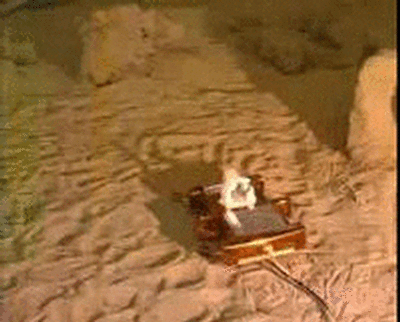
Non-Nominal Walking mode
If WAROMA flipped over, happening quite possible in rough terrains, WAROMA was able to walk with the instruments down until it could recover the normal walking mode.
Recovery mode
After turning over (see the section before), WAROMA has good recovery capabilities to come back to its nominal vertical attitude just moving appropriately one or several legs.
Sensoring / Actuation aspects
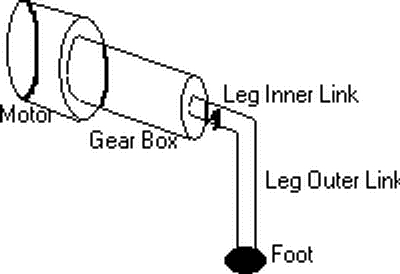
Unlike wheeled rovers, in the motor/leg position had to be perfectly known in this concept. The coordination of all the legs during time slots (called "gait") made use of angular position sensors on each leg. These were the possible actuation schemes envisaged for WAROMA:
- Four independent gears/motors.
- Two independent gears/motors, each one for an axis (front / rear or left / right). Several gears, including the gear change devices, were needed to modify the relative motion between two legs to cover the gaits for each operation mode.
- One motor including several gears were needed as in the option before.
The leg design was another key locomotion aspect. The length of its inner link is related mainly to stowage capability and walking stability. The length of its outer link is related mainly with obstacle climbing capabilities and energetic losses. The foot design is related with the desired sinkage in the terrain and the right friction to climb obstacles. In the same way, the required leg flexibility is also coming from these design aspects.
Implementation
The WAROMA concept was implemented in the "PROtotype of LEgged Rover" (PROLERO) activity.
In this activity the concept of WAROMA was extended with an additional set of legs (bringing the total to 6 legs) which allowed more advanced gait schemes.
PROLERO was tested in the WAROMA configuration (4 legs) at the ESA's Planetary Utilisation Facility/B (PUTB). Tests confirmed the validity of the concept.
References
- "Walking Robots for Planetary Exploration Missions", A. Martin-Alvarez, W. de Peuter, J.Hillebrand, P.Putz, A.Matthyssen, J.F. de Weerd, WAC'96, Second World Automation Congress, May 27-30, 1996, Montpellier, France.


